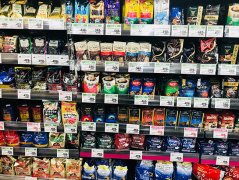What are the decaf coffees available: Papua New Guinea CO2 decaffeinated Yehe small Farmers batch

Professional coffee knowledge exchange more coffee bean information please follow the coffee workshop (Wechat official account cafe_style)
The origin and development of decaffeinated decaf coffee: why are all Swiss water-treated decaf coffees sold?
Papua New Guinea Wild River Decaf
The goods that arrived this time are the well-received Yehe low-caffeine batch!
The Moanti family of Papua New Guinea has attracted the Osher team for cup testing and procurement for the third time.
We specially discussed with fruit growers to make this batch of CO2-treated raw beans with low caffeine!
The coffee farmers' organization-Kiviringka community, established by Ms. Mrs. Moanti Ise, can produce more than 100 tons of raw beans every year, and 260 coffee farmers take part in the weaving. This is the Sustainable Management Services (SMS) project, with the assistance of exporters and international organizations such as the World Bank, with the aim of successfully building a raw bean supply chain, the main producing area is in the eastern high-altitude Donatina Valley-Dunatina Valley,Eastern Highlands), and the local administrative province is-Henganofi District.
Wild River is a small block in the Vetina Valley. Wild River in the region is a gathering place for local farmers and is also a supplier for this batch.
Farmers in Yehe region plant about 1000 coffee trees per household, including ladder card, bourbon and Arusha, and Osher's batch of low-caffeine pickups (Typica), only those with a cup test of more than 85 points are selected for low-caffeine treatment.
To go to Yehe and Donatina Valley, you need to go by Goroka, the mountain is steep but the scenery is green and beautiful. Coffee farmers in the mountain areas, especially members of the Community Alliance, have learned to pick ripe cherries by hand, screen the first stage of immature fruits and sundries with water, remove the peel and pulp with a small peeling machine, and then ferment for about 36 hours. then wash it, and bask it in the sun with a scaffolding. the following is a picture of the work of small farmers:
The following is the test data of this batch of Yehe decaf cups:
Producing country: Papua New Guinea
Producing area: eastern Highlands, Donatina Valley (Dunatina Valley,Eastern Highlands)
Administrative province: Henganofi District
Production area: Wild River micro lot, Kiviringka community
This batch of varieties: ladder card
Treatment: CO2 low caffeine treatment (raw bean ends are still washed and transported abroad)
Planting altitude: 1800 to 1900 m
Harvest time: 2017 latest arrival
Cup test report:
Dried incense: sucrose, herbs and cocoa
Wet fragrance: sucrose, herbs, hazelnut sweet, bitter sweet chocolate
Sipping flavor: citrus peel, sweet sucrose, herbs, cocoa, cinnamon aftertaste.
What is decaf coffee? what are the advantages and disadvantages of drinking decaf coffee?
Important Notice :
前街咖啡 FrontStreet Coffee has moved to new addredd:
FrontStreet Coffee Address: 315,Donghua East Road,GuangZhou
Tel:020 38364473
- Prev

What is decaf coffee? Palpitations insomnia or pregnancy re-election decaffeinated coffee can you compare healthy?
Professional coffee knowledge exchange More coffee bean information Please pay attention to coffee workshop (Weixin Official Accounts cafe_style) The origin and development of decaf coffee: Why are all Swiss water treatment decaf coffee sold? Are you worried about heart palpitations, insomnia, or switching to decaf coffee because of pregnancy? Coffee drinkers who want to consume less caffeine are actually related to coffee bean varieties and grinding
- Next

What are the differences in the taste of decaffeinated coffee available in Japanese supermarkets?
For more information on coffee beans, please follow the origin and development of low-caffeine and low-caffeine coffee in coffee workshop (Wechat official account cafe_style): why are all Swiss water-treated decaf coffees sold? For friends who want to drink coffee and black tea but are worried about excessive caffeine intake, they can consider buying low (non) caffeinated drinks while pregnant or breastfeeding.
Related
- Beginners will see the "Coffee pull flower" guide!
- What is the difference between ice blog purified milk and ordinary milk coffee?
- Why is the Philippines the largest producer of crops in Liberia?
- For coffee extraction, should the fine powder be retained?
- How does extracted espresso fill pressed powder? How much strength does it take to press the powder?
- How to make jasmine cold extract coffee? Is the jasmine + latte good?
- Will this little toy really make the coffee taste better? How does Lily Drip affect coffee extraction?
- Will the action of slapping the filter cup also affect coffee extraction?
- What's the difference between powder-to-water ratio and powder-to-liquid ratio?
- What is the Ethiopian local species? What does it have to do with Heirloom native species?

